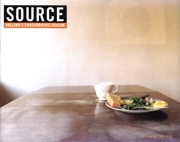Amongst Women
Photographs by Hannah Starkey, Interim Art 25th October - 28th November 1998
Review by Paul Tebbs
Issue 17 Winter 1998
View Contents ▸
In previous works, Hannah Starkey created what appeared to be accidental meetings of female strangers, found together on the top of a bus or within the reflection of a mirror. The significance of these encounters was ambiguous. One was unsure as to whether the significance was accidental, an illusion created through the privileged position afforded the spectator, or real for the people within the scene. But Starkey's compositions are anything but accidental. There is within every detail a considered intent. In her latest work shown at Interim Art, the physical closeness of the women and girls suggests a familiarity. We appear to witness an encounter between friends or relations.
In one image, a teenage girl is slouched at a table in a bar wearing an Arsenal football shirt. In front of her is a much older woman, with her back to the viewer, sitting upright. An ostentatious earring hangs from her aged profile. The slumped posture of the teenage girl could be the result of boredom - taken away from her friends into an uninteresting (and uninterested) adult world, bought off with a Coke. Alternatively the meeting could be confrontational, with the girl having been told off, looking disdainfully past the uncomprehending adult. Between the aspirational earring and the disconsolate teenager, cigarette smoke rises, lightly veiling the palm-beach advertisement on the cigarette machine beside them.
Whatever the reading, the teenager does not want to be there. She sits, aggrieved but compliant. This is symptomatic of an active / passive distinction apparent between the friends presented. For example in one photograph, the eldest of the two females attends to her make-up while sitting at a table in a bar. Her younger friend pays no attention and looks dreamily in front of her, her coffee cup held a few inches above the table surface. In another image, a woman tries on a silky top in front of a mirror in a clothes shop. Her younger friend stands back and observes, playing with the same top in pink, which she drapes across her body, the hanger resting behind her neck. It is unclear as to whether the mock wearing is a selfless evaluation of her friend's prospective buy or an imaginative purchase of her own. These scenarios describe different attitudes held by young women to potential influences around them, namely relationships with older women. The younger of the two often seems unable to assume the same kind of control, either subject to the elder's authority - without purchasing power, forced to wait, still dependent - or simply not interested.
Starkey also works as a commercial fashion photographer. These 'art' photographs although aesthetically related to the genre, are located at a different place in the determination of identity. Instead of the disengaged ideals of fashion (even disaffection is transcendent), we see the localized influences we all have little choice but to grow up with. An everyday context of influence. Starkey's assiduous orchestration of details means that these fictional characters cannot escape a degree of social classification (as is the case for all of us). In this sense the pictures are only minimally about individualized people. The real subject seems to the designation of identity (class and gender) through social signifiers, and more specifically the role of women in this process of construction.
Disarmingly, the physical posture of the younger person will often be a mirroring of the older person's, but with noticeable differences. The younger person is more slumped, holds a cup of coffee instead of an eye-liner pencil, has hands opened upwards while the older friend's hands are held limply downwards (a strange neutrality before her own image in the mirror). Formally this is suggestive of either the unconscious copying of friends or an inevitable similarity of destiny.
Technically and formerly the images are rewarding (they are large 122cm x 152cm). The spaces chosen are lit by natural and artificial light that invites formal comparisons with Dutch 17th century paintings (Vermeer, De Hooch), these paintings in contrast to Starkey's photographs, fix a domestic environment where the female's role is summarized in the Dutch platitude 'housewife is your name, a word that signifies your duty'. With Starkey's photographs we move amongst women in different environments, hopefully we have progressed.
Other articles by Paul Tebbs:
Issue 27: Other Pictures by Thomas Walther - Floh by Tacita Dean [Book Review] ▸
Issue 27: Fotografien 1991-1995 by Laurenz Berges [Book Review] ▸
Issue 27: Towards A Philosophy Of Photography by Vilém Flusser [Book Review] ▸
Other articles mentioning Hannah Starkey:






